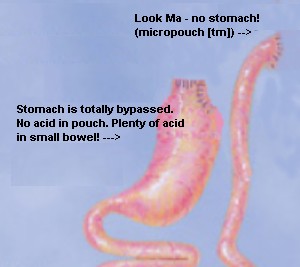|
What is the micro pouch? |
We have had questions now and then, about a type of gastric
bypass which creates (what the surgeons term) a micropouch (tm). I have
studied their website and even some medical documents but could not for the
life of me, figure out what was different about this surgery. A couple of years ago, these doctors, Dr Sapala and Dr Wood, applied (and obtained)
a US patent on this surgery. And the article announcing this explained the details about the
micro pouch. A couple of years ago, these doctors, Dr Sapala and Dr Wood, applied (and obtained)
a US patent on this surgery. And the article announcing this explained the details about the
micro pouch.It is apparently the size of a grape and formed from the "cardia" of the stomach, a non stretchable part of the stomach which according to Drs Sapala and Wood, "contains very few acid cells". The article added that the doctors say there is no gastric reflux with a micro pouch and 95 percent of their patients lose a lot of weight. First of all, the pouch in ALL gastric bypass procedures is formed from the ring of muscle at the top of the stomach, the "cardia". Secondly "very few acid cells" is true of all gastric bypasses except the very old ones which left a bit of the stomach to digest food. Another name for the cardia is the LES or lower esophageal sphincter or valve because it's not really PART of the stomach. (Could that be why it's called a gastric bypass - because it bypasses the stomach?) ;) So, far as we can see, the only difference between the micropouch and the RNY pouch is size - the micro pouch is the size of a grape. The RNY pouch is the size of a very small egg. i.e. if gastric bypass patients have almost no stomach, micropouch patients REALLY have no stomach. Some folks think not having a stomach isn't a very good idea like Dr Paul Ernsberger, Associate Professor in Case Western Medical School: All of the operations, old and new, are based on an
incorrect assumption: that the stomach is no more than a passive sac for
receiving food. In fact, it is a critical digestive organ and cannot be cut
away or bypassed without compromising the digestive process.
As with all procedures, one can STILL gain weight by eating liquid or soft foods (foods which go down easily) or grazing, so a smaller pouch may NOT mean that you won't regain the weight. Also a smaller pouch may make micropouch patients higher risk for esophageal hernia (like when the food collects in the esophagus after you fill your grape size pouch). And once you got something wrong with your esophagus, it's really hard to fix (as I, having scar tissue from GERD and a foolish medical procedure, the esophagoplasty, can attest to). Here is the patent application and description for the micropouch. Dr Sapala moved from Michigan to Brookhaven Memorial Hospital in New York. |